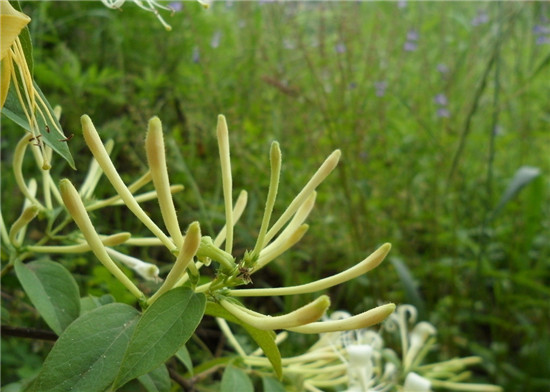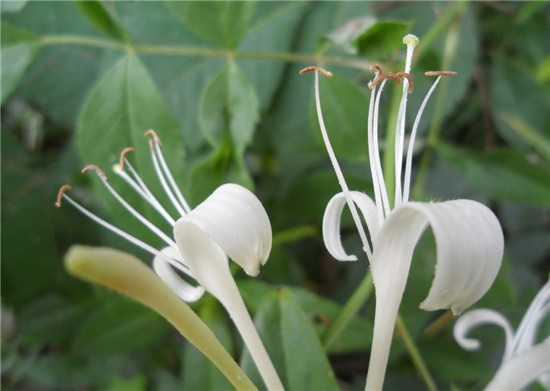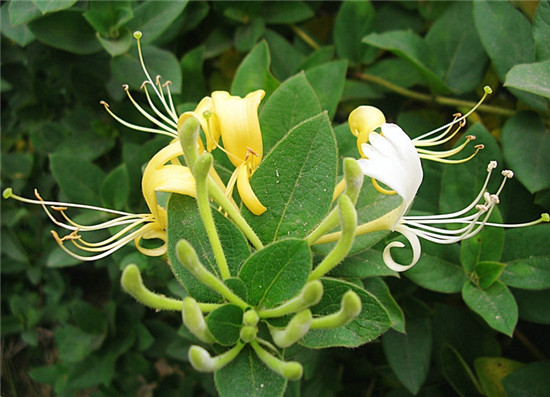The function and Culture method of Flos Lonicerae
Honeysuckle is also called honeysuckle vine, mandarin duck vine or double flower because it is a kind of rattan plant. Next, let's understand the function and culture method of honeysuckle vine.

Varieties of honeysuckle vine
South China honeysuckle: the difference between this species and Ninjuriaceae is that young branches, petioles, peduncles, bracts and bracteoles are all gray-yellow curly pubescent and sparsely glandular hairy; branchlets are reddish brown or nearly brown. Leaf blade ovate to ovate-oblong, both surfaces hispid when young, glabrous above when old. Bracts lanceolate, 1-2 mm long; bracteoles apex ciliate; calyx tube pilose. The fruit is black. The flowering period is from April to May, and the fruit ripening stage is October.
Honeysuckle: this species differs from the first two in that the leaves are sometimes pink-green, stalked or with a very short stalk of yellow to orange mushroom-shaped glands. Bracts linear-lanceolate, nearly as long as calyx tube, outside hispid and ciliate; Corolla white, sometimes reddish, then golden, outside sparsely anatropous puberulent, and often with sessile or shortly stipitate glands. The fruit is sometimes powdered. The flowering period is from April to June and the fruit ripening stage is from October to November.
Flos Lonicerae: this species differs from the first three species in that young branches, petioles, leaves, total pedicels, bracts, bracteoles, and calyx teeth are densely covered with yellow-brown felts or curved yellow-brown felts, with hairs no longer than 2mm, and short orange-red short glandular hairs scattered on both sides of young branches and leaves. Leaf blade papery, ovate-oblong to oblong-lanceolate. Bracts subulate; bracteoles ovate to linear-lanceolate; there are no bracteoles below double flowers; Corolla and bracts are short, densely covered with yellow-brown inverted hairs and spreading short glandular hairs. The florescence is from June to July.

The functions and effects of honeysuckle vine are as follows:
1. Treatment of hemorrhoids and fistulas. Use honeysuckle vines (including flowers, stems and leaves) no matter how much, soak in wine, simmer overnight, take out and dry, add a little licorice, research together for the end, mix noodles with soaked wine and paste into balls, such as Wuzi. Take 50 to 100 pills, boiled water or wine. The name of this prescription is "honeysuckle pill".
2. Treat all swelling and poison (no matter whether it has been routed or has an initial fever). Use honeysuckle vines (including flowers, stems and leaves), fry half a bowl of natural juice to 80%, and apply medicine dregs to the affected area.
3. Treat eczema and stool poison, larynx arthralgia milk moth. The prescription is the same as above.
4. the treatment of acne is not cured. With honeysuckle vine, smash, add male Juan five points, two liters of water, put into the pot of suffering, paper seal several times, pierce a hole, make the gas out. Heat fumigation of the sore to the hole, wait for the sore to produce yellow water, and then use myogenic medicine, the disease will be cured.

5. treatment of heat-toxic blood dysentery. Use honeysuckle vines to fry and drink.
6. Treat the blueness of the body. Use honeysuckle vine (including flowers, stems and leaves) one or two, fry water suit.
7. Treat beriberi (pain caused by muscles and bones). Use honeysuckle vines (including flowers, stems and leaves). Two yuan per serving, mix down the hot wine.
8. Treatment of wild bacilli. Pick honeysuckle vine fried clothes.
Culture method of Flos Lonicerae
Honeysuckle can be sown with seeds from black berries, and can also be propagated by cutting, pressing and dividing plants.

Honeysuckle can climb flower racks, hedges, walls. The fragrance of the flowers is pleasant, especially the honeysuckle of the four seasons, from spring to autumn, the flowers are constantly interlaced with gold and silver. if planted in the courtyard, you can enjoy the flowers and smell the fragrance; in the hot summer, it is even more enjoyable to enjoy the cool and shade under the honeysuckle rack.
Honeysuckle has no special requirements for soil, general soil can grow, but should not be planted in too shady, too dry and too wet, stagnant water. In the second year after planting, you should set up flower racks or move close to hedges and walls in order to find things to cling to, winding and climbing.
Three or four years later, it is appropriate to carry out a shearing to cut off the cluttered and crossed branches, otherwise it is too crowded and easy to cause aphids, insects and other pests; at the same time, it can promote ventilation, light transmission, and conducive to flowering. It is also necessary to water the flowers in a timely manner during the drought season so as not to make the flowers fall due to drought. Amoy rice water, wash fish, meat dirty water, fully fermented can be irrigated. If aphids and shell insects are found to be harmful, they should be sprayed with 1500 times dimethoate or soaked in tobacco leaves. Soot disease is also easy to occur in high temperature and drought, which can be controlled by topiramate or carbendazim.
These are all the contents of the functions and training methods of honeysuckle vine that I have summarized for you. I hope this article can help you all. Please continue to follow us.
Related
- Wuhan Hospital Iron Tree Blooming Result Was Instantly Frightened by the Gardener Master
- Which variety of camellia is the most fragrant and best? Which one do you like best?
- What is the small blue coat, the breeding methods and matters needing attention of the succulent plant
- Dormancy time and maintenance management of succulent plants during dormancy
- Minas succulent how to raise, Minas succulent plant pictures
- What are the varieties of winter succulent plants
- How to raise succulent plants in twelve rolls? let's take a look at some experience of breeding twelve rolls.
- Attention should be paid to water control for succulent plants during dormant period (winter and summer)
- Watering experience of twelve rolls of succulent plants
- Techniques for fertilizing succulent plants. An article will let you know how to fertilize succulent plants.



